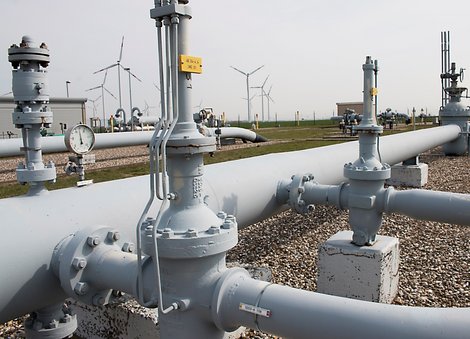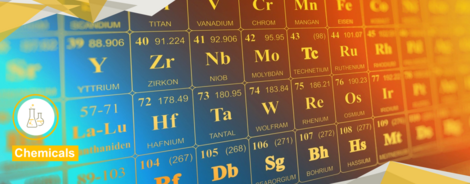Potential as a Model Region for Green Hydrogen

Central Germany has all the components of the value chain for the energy source of the future.
The German government’s National Hydrogen Strategy aims to transform the country into the world’s leading supplier of modern hydrogen technologies. When it comes to developing a green hydrogen economy, Saxony-Anhalt is a pioneer, having already seen innovative ideas grow into lighthouse projects. Central Germany’s model region for hydrogen is home to an entire value chain that produces green hydrogen using renewable energies, stores it and transports it.
“Lange Lauchstädter Straße” (Long Lauchstädter Street) between Teutschenthal and Bad Lauchstädt lives up to its name, stretching away into the distance left and right, with wind turbines on the horizon. What you can’t see is the underground salt dome that stores natural gas – where something visionary is going on: it is the first storage cavern in the world to store green hydrogen from renewable energy sources.
“That means we have some lighthouse projects to offer,” says Florian Thamm, Marketing Manager at the HYPOS Consortium, or Hydrogen Power Storage & Solutions East Germany, to quote the full name of the business and research network. In 2013, Central Germany embarked on setting up a model hydrogen region. That kind of sustainable thinking is a big hit with the German Federal Ministry of Education and Research in Berlin. HYPOS was accepted by the “Twenty20 – Partnership for Innovation” program. As an energy source, hydrogen plays a decisive role in the success of the energy transition – provided it is not made in the conventional way, from natural gas. The climate-neutral electrolysis process splits water into hydrogen and oxygen using renewable wind or solar energy, creating a totally emission-free cycle.
The hydrogen factory of the future
The model region for hydrogen is set to represent a complete H2 value chain, from production to storage and transport. It starts by developing new electrolysis systems in order to be able to produce climate-neutral, cost-effective green hydrogen. HYPOS members Siemens AG, Linde Aktiengesellschaft and the Fraunhofer Institute for Microstructure of Materials and Systems (IMWS) are cooperating on the “Central German GreenHydroChem” project funded by the federal government after winning the “Living Labs for the Energy Transition” ideas competition. At the Chemical Park Leuna, the biggest green hydrogen production electrolysis unit in the world – with an output of over 100 megawatts – is under construction. Likewise, the ELP electrolysis testing and trials platform is under way along with a scaling platform. The green hydrogen produced there on a large-scale will be used to manufacture sustainable base chemicals and fuels. The scientific driving forces behind the unit, which is funded by Saxony-Anhalt, are the Fraunhofer Centre for Biotechnological Processes (CBP) in Leuna and the Fraunhofer Institute for Microstructure of Materials and Systems (IMWS) in Halle (Saale). TOTAL Raffinerie Mitteldeutschland GmbH in Leuna operates the facilities.
“Since it isn’t possible to build wind farms and solar parks everywhere, we’re also backing location-independent solutions for the production of hydrogen, and where necessary, using biogas plants as well,” says Torsten Birth, highlighting a special fermentation process that can be used to produce hydrogen from organic raw materials. Birth heads up the Energy and Resource-Efficient Systems team at the Fraunhofer Institute for Factory Operation and Automation (IFF). The IFF is currently developing the concept for the hydrogen factory of the future, which will comprise needs-based decentralized modules for the production and distribution of green hydrogen.
A “hydrogen village” at the Bitterfeld Chemical Park
One link in the value chain is the aforementioned salt dome at Bad Lauchstädt, where VNG Gasspeicher GmbH is constructing new caverns ready for test operations with green hydrogen. The hollow space will have a capacity of some 3,800 tonnes. “The energy content of this volume of hydrogen is equivalent to the annual power consumption of around 40,000 two-person households,” says Florian Thamm, drawing a vivid comparison. He goes on to say that for the area around the center of Halle-Leipzig and the neighboring towns, forecasts put sales of green hydrogen at approximately nine billion cubic meters per year by 2050.
It is no coincidence that HYPOS is operating across the tradition-steeped Böhlen-Leuna-Bitterfeld chemical triangle, which already has a 150-kilometer hydrogen pipeline as well as long-standing specialist expertise on account of its heritage. A converted natural gas pipeline will transport the hydrogen between the chemical triangle and the storage facility in Bad Lauchstädt.
To verify that the gas infrastructure will also work with pure hydrogen, Mitteldeutsche Netzgesellschaft Gas mbH (MITNETZ GAS) built the HYPOS H2 network. The hydrogen village, as it has been dubbed, opens the first green chapter in the 126-year history of Saxony-Anhalt’s Bitterfeld Chemical Park. The innovative showcase project was built on Chlorstraße and covers 12,000 square meters of land. On open days there is a keen interest in the live H2 test area where the use of green hydrogen is undergoing technical, economic and ecological evaluation. And it comprehensively illustrates how supplying a residential area, for example, can work with this sustainable energy source.
H2, a lighthouse that shines internationally
Potential buyers include not only urban energy suppliers but above all, the chemical industry and energy-intensive industrial enterprises in heavy goods, maritime and air transport, says Florian Thamm. The IFF’s Torsten Birth also envisages applications for decentralized energy supplies as well as mobility – specifically, hydrogen-powered cogeneration plants and vehicle fleets with vans and forklifts in business and industrial parks. “The fuel cells in cars can reconvert hydrogen to electric energy for driving,” says Birth, who is convinced that “we will see green hydrogen through to success on an industrial scale.” HYPOS spokesman Florian Thamm agrees: “The wide range of research work and activities among HYPOS partners, the development of a hydrogen factory and the ELP platform are excellent lighthouse projects with national and international reach. If we can get to the stage of industrial application, green hydrogen will be not just the key energy source for the energy transition but a boost to the whole economy.”
Author: Kathrain Graubaum/IMG Saxony-Anhalt
HERE the chemistry is right.

Traditionally, Saxony-Anhalt offers the complete value chain from basic chemicals to the processing industry. In the fields of polymer synthesis, agrochemicals as well as fine and specialty chemicals, the state has developed into a leading competence center. A distinctive raw materials network, supported by the state's 5 chemical parks, creates profitable synergy opportunities.
